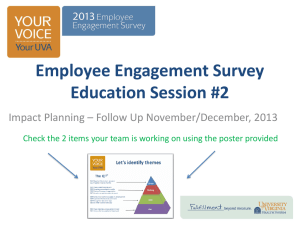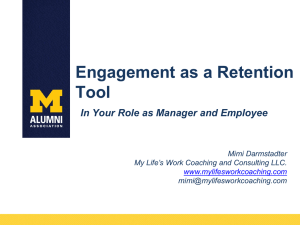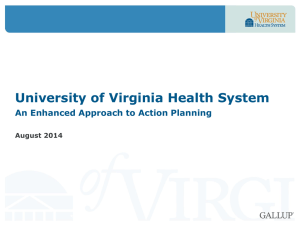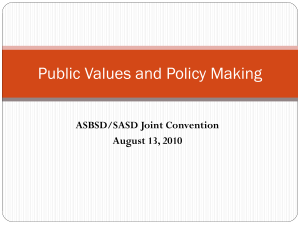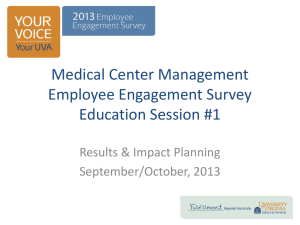Compilation of Q12 Best Practices - University of Virginia Health
advertisement
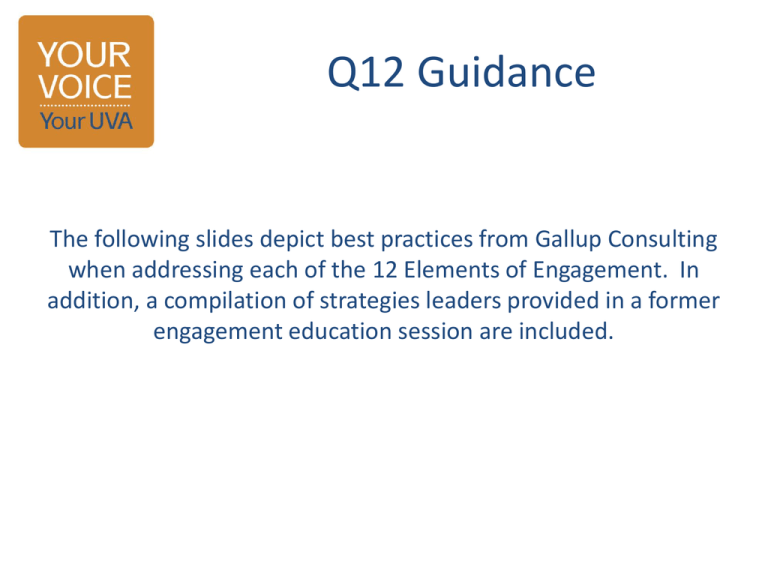
Q12 Guidance The following slides depict best practices from Gallup Consulting when addressing each of the 12 Elements of Engagement. In addition, a compilation of strategies leaders provided in a former engagement education session are included. Q01 – Know what’s expected Best Practice Strategies from Gallup Set aside time to explain to each team member how his or her role contributes to workgroup success. Hold a one-to-one meeting with each team member to set performance expectations. Improve accountability by involving team members in setting their own individual performance goals. Seek opportunities to provide informal feedback to individual team members. How Medical Center Workgroups have responded • • • • • • Commit to the ideal that everyone is here to heal patients directly and indirectly Incorporate into Buddy Program & Onboarding processes Ask everyone to sign RISE values and behaviors Shadow other disciplines Establish visuals of goal progression Share experiences/ teachable moments with peers • Team members define expectations of each other then revise job descriptions • Rephrase “My expectation of you” to “My vision for you” • Gain commitment of everyone to read meeting minutes and seek clarification when uncertain • Ensure standard work processes are understood and followed • Educate direct reports on Be Safe Team Member Essentials and encourage the use of the help chain for quality and safety concerns • Discuss goal progress in every 1:1 meeting • Review strategic plan in team meetings • Implement train the trainer program to educate on required competencies • Share and discuss Friday’s Before Five information and findings • Review job description every 6 months • Create and implement a peer review form • Provide education on how to give and receive peer to peer feedback • Commit to engaging in daily huddles • Identify and utilize mentors Q02 – Have materials and equipment Best Practice Strategies from Gallup Provide your team members with the tools and equipment needed to perform their duties efficiently and effectively in order to prevent work disruptions. Involve team members in problem-solving methods that are needed to do their job right. Teach team members how to access the information they need to do their job right. Create an open dialogue with team members that encourages them to talk about what they need to perform their job effectively. How Medical Center Workgroups have responded • Upgrade/repair equipment and provide necessary inservices and updates on backorders • Review what improvements had occurred and positive impact • Send requesting team members to additional training • Enhance workflow by implementing mobile workstations • Involve team members in budget process • Discuss ways to ask for and share resources with other areas • Discuss the difference between need and want • Assess par levels • Ensure proper use of equipment location tags • Implement daily huddles with physicians to address potential issues • Utilize volunteers when reorganizing resources • Post supply list and rotate responsibility among team members • Arrange for ergonomic evaluation of work environment • Educate team on how equipment and supplies are received • Teach team members how to observe work processes in an attempt to create standard work and eliminate variation/waste • Promote in the moment communication regarding needs and issues • Establish frequent check ins/rounding with team members • Discuss what this element means to each person • Create “Wish Lists” • Provide opportunity for Supply Chain to shadow Nursing • Establish suggestion box and ask team to vote on priorities Q03 – Opportunity to do best Best Practice Strategies from Gallup Learn what inspires team members to do their best work. Interview each of your team members to assess their individual strengths and weaknesses. Match individual team member's talents with role requirements. Encourage team members to use their strengths in their roles. How Medical Center Workgroups have responded • Discuss “What does doing your best mean to you?” • Clarify the difference between responsibilities and likes • Encourage team to pick a specialty of work of interest • Promote evidence based practice • Discuss 50th percentile and ask if this is where we want to stay • Provide support and opportunities for everyone • Ask candidates during interview about their passion when determining job fit • Each team member shares or demonstrates unique gifts/talents • Utilize project charter to maintain organization and create priorities • Tie personal interests to the job role • Provide additional assignments to team members who aspired to go above and beyond job expectations • Empower team members to work collaboratively to create standard work processes • Discuss what enables people to do their best • Take advantage of free/inhouse resources and training • Provide resources to allow for additional opportunities • Focus on breaking down perceived or real barriers • Discuss internal promotion opportunities and Informal Leader class Q04 – Recognition Best Practice Strategies from Gallup Give formal recognition to team members. Encourage team members to acknowledge the good work of others. Learn how each of your team members likes to be recognized, and tailor your approach to meet their individual needs. Model praise and recognition behavior for team members. How Medical Center Workgroups have responded • Implement local Team Member of the Month, Star Awards, Kudos Awards, High Five, Pat on the Back, which recognize valued behaviors and actions • Implement locker decorations for new hires and special events • Provide welcome letters to new team members before they start • Celebrate important and significant life events • Promote peer to peer recognition via emails, Bravo Cards, • Discuss the importance of saying “Thank You” daily • Incorporate a tribute to a team member in newsletter and team meetings • Recently recognized team member responsible for recognizing another team member the following week • Pass around “You Rock” award between team members for good deeds • Ask “How do you like to be recognized?” and utilize that knowledge to determine appropriate recognition strategy (who, what, where, when, how) • Commit to every team member having a role in organizing and planning a team social event • Announce recognition and praise efforts at beginning of team meetings • Distribute and display RISE nominations/awards • Encourage physician participation • Adopt a practice of giving 2 Bravo cards each shift • Distribute group email when goals were met • Look for opportunities to recognize team members who call attention to potential quality and safety issues Q05 – Cares about me Best Practice Strategies from Gallup Talk one-to-one with team members regularly. Make communication a top priority for all team members. Encourage team members to share their work challenges and concerns with leadership and each other. Communicate often during times of change. How Medical Center Workgroups have responded • Meet regularly to make personal connections • Walk the floor with each team member each day • Implement daily team member rounds and asked “How can I help?” • Shadow team members every 6 months for 4 hours • Team members check in with each other during difficult times which impact work (weather, illness, etc.) • Team members work together to ensure everyone gets to take PTO while maintaining adequate staffing • Involve team members in operational decisions • Encourage team members to proactively improve relations with their coworkers • Model an environment in which professional safety is a top priority • Engage in difficult conversations to convey “I care about you” • Provide weekly updates on staffing challenges • Discuss rumors and facts • Discuss employee engagement initiatives at monthly team meetings Q06 – Development Best Practice Strategies from Gallup Establish development goals for team members in their current roles. Be available to give guidance and advice to team members. Encourage an atmosphere of continuous learning among your team. Encourage team members to share their knowledge and skills with one another. How Medical Center Workgroups have responded • Ask team members semiannually “What are you interested in?” • Define specific quality and safety developmental opportunities • Provide formal supervision opportunities when required by certification body • Match clinical ladder opportunities to strong professional mentors and held quarterly meetings • Encourage chairing/cochairing of meetings) • Require medical terminology training • Discuss ways to recover from inevitable set backs • Ask team members to provide ROI for requested training dollars • Encourage peer supervision and feedback • Develop Q&A template on O drive for team members to ask questions / get responses to topics presented at team meetings • Select one competency to focus on per month • Support research projects developed by team members • Be available in real time to coach team members • Establish certification study groups • Encourage attendance and conferences and meetings • Provide profession related books during national recognition week • Ensure timely turnaround for development requests for support • Encourage participation in Informal Leader series and teach back of concepts learned • Offer a development class each quarter • Encourage job rotations and cross training in areas of interest • Encourage publishing • Hold quarterly meetings devoted to development topics • Provide team members with time to participate in local talks (Schwartz Center Rounds) • Discuss and coach to case study reviews in team meetings • Require all team members to present one in-service a year • Share A3s and learnings Q07 – Opinions count Best Practice Strategies from Gallup Host a team meeting to ask for suggestions and listen to concerns. Follow up on commitments from meetings. When a team member requests to talk about something, immediately schedule a time to listen. Advocate for your team members; get others to consider their opinions and suggestions. How Medical Center Workgroups have responded • Role model and encourage active listening • Implement small group meetings to solicit feedback on ideas • Purposefully ask each team member for input • Ask “What does it look like to have your opinions heard?” • Empower team to take control and ownership of ideas • Purposefully close the loop and provide feedback on ideas brought forward • Create a central issues list • Revisit ‘parking lot’ issues • Create a log book to communicate to management when team feels opinions didn’t count • Create a template to track ideas and concerns • Create work group activities to address concerns • Limit the use of email to solicit ideas and promote face to face conversations • Establish monthly employee engagement forum • Round throughout the department frequently to actively seek quality and safety concerns • Ensure the Help Chain is understood and used • Demonstrate that opinions counts by actually trying and implementing new team ideas • Promote continual improvement by soliciting feedback on the onboarding process • Provide public acknowledgement of changes made based on suggestions • Establish communication pathway between senior leaders and management teams Q08 – Mission/Purpose Best Practice Strategies from Gallup Tie company mission to every team member’s role Recognize team members' talents and indicate how they contribute to the department and company mission Align goals with company mission and purpose Provide examples of how missions come alive in the everyday business How Medical Center Workgroups have responded • Encourage every team member to introduce him or herself during team meetings in terms of how they contribute to the company mission • Share and discuss organizational and division metrics at team meetings • Amend the mission to address desired behavior changes • Highlight Dr. Shannon’s video message in team meeting • Develop unit mission statement with input from all team members • Integrate Uteam Rewards and Bravo cards to RISE values • Discuss why we do what we do everyday • Create a ‘Journey’ board • Post and update clinical outcomes board • Look for opportunities to tie talents and accomplishments back to quality and safety • Help team members identify their internal customers • Tie all initiatives to organizational values • Incorporate RISE values into each team meeting agenda • Read mission statement at team meeting and ask team member to describe what it means to them • Ask each team member to discuss how Be Safe changes the way they work • Share patient experience letters with team members • Ask team members to create work unit mission and purpose statements • Share stories which demonstrate connections to mission • Share case reviews whereby patients were positively impacted Q09 – Committed to quality Best Practice Strategies from Gallup Ensure new team members are trained appropriately about quality. Set quality standards for the workgroup so that every team member has a common reference point. Ask team members to help develop the quality standards. Educate the team about the implications and effects of substandard quality. How Medical Center Workgroups have responded • Provide training/ follow up when quality is compromised • Effectively deal with poor performers • Remove obstacles to improve performance through UBLs • Establish QA process for supervisors to mentor team members • Promote environment of areas for opportunity versus punitive/blaming environments • Encourage team to view Dr. Shannon’s video message – top down commitment to quality • Define quality metrics for each unit • Increase physician/nurse collaboration • Implement shadowing program with upper levels of leadership • Educate team members on how to give and receive feedback • Encourage team members to participate in quality initiatives • Create team approach on projects to ensure great ideas and approaches • Standardize processes • Identify pitfalls and system complexities in communication patterns • Submit evidence based practice posters • Train new hires on Be Safe in your unit/department • Incorporate Appreciative Inquiry practices • Discuss importance of trusting each other to always demonstrate safe practices • Share individual learnings with entire team • Review quality metrics at weekly huddles • Create standard work to remove variation/waste in work processes Q10 – Best friend at work Best Practice Strategies from Gallup Encourage team members to develop supportive relationships with one another. Facilitate an in-depth discussion about the definition of "best friend at work" during the engagement action planning meeting. Encourage your team members to celebrate "special events" for one another (e.g., birthdays, anniversaries, etc.). Create opportunities for team members to work on projects with other team members they enjoy working with. How Medical Center Workgroups have responded • Implement “buddy” onboarding process • Assign Clin 3s to each RN to serve as a resource • Display travel outside of work pictures • Create “Secret Pals” who perform random acts of kindness throughout the year without revealing identity • Interpret as someone who: makes my day better, has your back, has your best interest at heart, you can connect with, supports you, you would turn to as a confidant • Explain why this question is asked and how it connects to quality • Discuss the difference between A best friend and THE best friend • Implement social gatherings based on what the team values • Implement monthly onboarding breakfast for new team members • Focus on interdepartmental collaboration opportunities • Implement job shadowing • Stress the importance of professional safety and inclusion • Include team members in UBTs for problem resolution Q11 – Progress Best Practice Strategies from Gallup Communicate with team members about their individual performance expectations. Document the performance progress of your team members. Meet with team members at least quarterly to review individual goals. Talk with underperforming team members to understand the current situation. How Medical Center Workgroups have responded • Discuss the importance of asking for peer feedback, demonstration and receiving feedback • Discuss organizational progress at huddles, team meetings, small work groups, weekly emails • Assess strengths and opportunities for improvement • Implement bi-annual performance reviews • Complete “fact sheet” by each team member, review and celebrate accomplishments • Utilize the A3 document to set timelines and expectations • Implement quality check-ins with each team member • Gather peer input when setting individual goals and share progress with quarterly basis • Encourage team members to present research at daily huddles • Hold crucial conversations • Share and discuss increases and decreases in errors Q12 – Learn & Grow Best Practice Strategies from Gallup Create an atmosphere of continuous learning. Talk with team members individually about their career goals. Promote learning about different areas of the organization Create incentives and rewards for team members when they further their learning. How Medical Center Workgroups have responded • Post continuing learning opportunities • Discuss the importance of individual advancement • Describe education as an opportunity to think through options • Implement a “year in review” exercise • Promote study groups • Implement a lunch & learn program • Present “Hot Topics” at team meetings • Implement a journal club – participants choose an article to review and discuss • Offer challenging projects which support team members to do their best everyday • Enable requested cross training and reassignments • Encourage team members to facilitate team meetings • Instill the idea of project ownership - “You own it” • Promote increased Learning Management System opportunities • Create annual professional goals • Encourage team members to challenge career ladder or promote to higher level roles • Organize guest speakers to attend team meetings • Educate other departments about our department’s services • Ask team members to bring topics to share at team meetings • Create and promote opportunities for team members for work with different teams • Promote Uteam meeting attendance • Increase in-services at team meetings based on requests • Increase clinical area tours for non-clinical team members • Create mentoring program • Celebrate significant successes • Nominate team members for participation in Informal Leader and Best Practices in Management development series • Focus on promoting from within • Encourage LEAN coursework and learning
